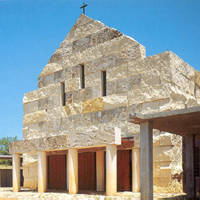Leonard L. Northrup Jr.
[6] Northrup married Jane Keliher and started a family in Dallas, where he designed and built one of the first single-family houses in the United States with central air conditioning.
With a Marketing Plan from G F Sweetman (CEO of American Awards Co), he became one of largest suppliers of Curtis Mathes fans and compressors in the nation.
In the late 1960s, Northrup bought a controlling interest in Donmark Corporation, a manufacturer of residential air conditioning and heating equipment from Curtis Mathes, his lifelong friend.
Northrup promoted the use of “all electric” central heating and cooling equipment, building a manufacturing facility in Dallas and later in Hutchins, Texas and selling primarily to apartment developers.
Such systems had already been commercialized in other countries where climatic conditions were favorable, energy costs were high, and there was a tradition of scientific innovation notably solar power in Israel.
Northrup’s break-through technology was a collector[7] that used a long curved acrylic fresnel lens to concentrate or focus sunlight at a theoretical ratio of approximately 12 to 1 onto a linear flat copper tube, coated with a variant of Dr. Tabor's “black chrome” absorptive surface.
This was sufficient to enable the array to track the sun’s azimuth and generate considerable heat, as reported in tests published in the ASHRAE Journal, which noted that ".
.follow the sun from just after sunrise to just before sunset and often results in the collection of twice as many usable BTUs of energy at a higher temperature than provided by high quality flat plate collectors.".
[8] These arrays proved popular – and were used to drive absorption refrigeration equipment on large commercial installations at Trinity University in San Antonio, Texas,[9] at Frenchman’s Reef Hotel in St Thomas, USVI, residences,[10] and were sold to prominent individuals, including movie actor and entrepreneur Steve McQueen, actor Stuart Whitman and environmentalist Robert Redford.
They created a good deal of publicity for Northrup, Inc., including the cover of Popular Science Magazine[11] and an article in Fortune Magazine that noted, "By squeezing (sic) sunshine optically, Lynn Northrup's unique new rooftop solar collector produces higher temperatures than are obtainable from most solar heating systems now on the market".
Emboldened with his success in concentrating collectors, Northrup turned his attention to achieving higher temperatures, with azimuth and elevation tracking mirrors "heliostats" focused on a central boiler – ie.
Northrup attended a conference there in 1973 along with Professor Yellott and Floyd Blake, a former Martin Marietta senior aerospace engineer who had become interested in solar thermal research.
Some heliostats were built to directly track the sun with arrays of photovoltaic cells to generate power for the utility grid, near Hesperia, California.
[15] The seven million watt installation near Barstow was later dismantled and shipped to Europe's first commercial solar thermal power station.
Northrup acquired 5,000 acres outside San Antonio, Texas, which was put into a trust for his family, and assembled land now occupied by the regional Rolex headquarters, among others.
At the other extreme in size, Northrup has utilized massive blocks of limestone for their passive heating / cooling characteristics, and free-standing structural qualities, most notably donating the stone and devising the construction technique for the Cistercian Chapel in Irving, Texas, which reflects both a classic design aesthetic and construction technique of mortar-less masonry - a thoroughly modern building built in the rational style of Cistercian architecture.
[18] Engineering Achievement Award, American Society of Heating, Refrigeration, and Air Conditioning Engineers Citation of Honor Award, American Institute of Architects for pioneering development of solar energy as a viable industry Honorary Member of Beta Beta Beta, biological honor society in recognition of significant contributions and outstanding service to society and biology Northrup's May 2006 patent describes a method with the potential for using water as a general refrigerant, as well as an economical method of desalinating water.






